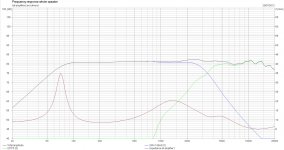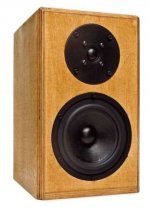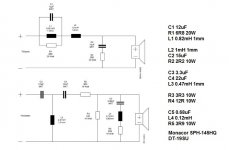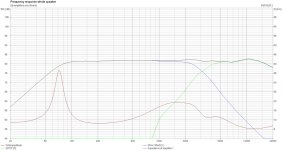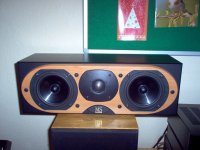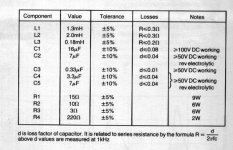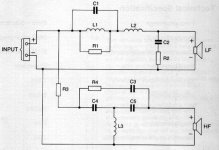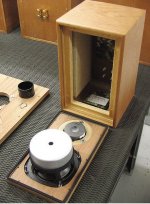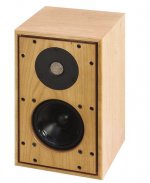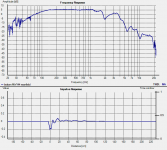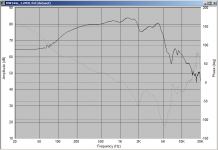This is how it simulates with this revision of the crossover. (this is with the HF adjustment section set at 0dB) Hopefully there are no mistakes in the crossover now.
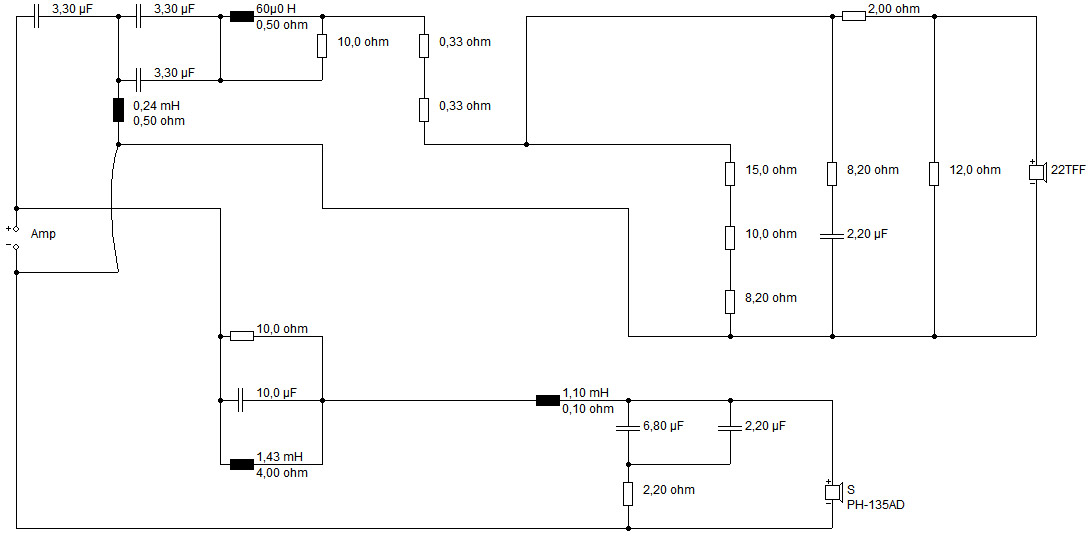
Anyway, performance wise, almost anything is likely to be better than the current cheap car speakers that are in my ceiling.

Anyway, performance wise, almost anything is likely to be better than the current cheap car speakers that are in my ceiling.
Attachments
Last edited:
How are you simming the drivers, Kei? Do you have the files? Do they just attach to BoxSim?
Note that the Zobel goes AFTER the attenuator and in front of the tweeter. For a Seas 22TFF @ 0.05mH Le and 4.9 ohm Re, you get 1.33uF and 6.2 ohms Zobel:
http://www.seas.no/index.php?option=com_content&view=article&id=284&Itemid=251
Impedance Equalization (L-Pad) Circuit Designer / Calculator
Very rough and ready, tweeter Zobels. 8 ohm and 1uF would probably be just as good. Very good for taming top-end harshness, especially with metal domes.
Note that the Zobel goes AFTER the attenuator and in front of the tweeter. For a Seas 22TFF @ 0.05mH Le and 4.9 ohm Re, you get 1.33uF and 6.2 ohms Zobel:
http://www.seas.no/index.php?option=com_content&view=article&id=284&Itemid=251
Impedance Equalization (L-Pad) Circuit Designer / Calculator
Very rough and ready, tweeter Zobels. 8 ohm and 1uF would probably be just as good. Very good for taming top-end harshness, especially with metal domes.
Last edited:
I had a look at the Italian designed clone that Raul linked to:
Audiocostruzioni - Il Portale dell'alta fedelt amatoriale
The Monacor SPH-130 paper driver is remarkably flat before filtering, though that is no guarantee of what happens with a filter. But the strange first order DT-19SU tweeter filter was frankly odd even if impedance was valve friendly. Phase was terrible and it's not in the smooth BBC tradition at all.
I much preferred the Monacor LS 5/19, which with the slightly more sophisticated Monacor SPH-145HQ and the DT-19SU looks the part. Drivers are available in the UK and Europe and cheapish:
Monacor SPH-145HQ HiFi Bass-midrange Speaker, 5½" 100W Max, 8Ω, 101420
Number One DT-19SU HiFi Dome Tweeter 80W.max, 101970
Strassacker: Lautsprecher - Boxen - Selbstbau
Test Lautsprecherbausätze - Monacor LS 5/19 -
Pictures of built speaker and crossover below. The series notch on the tweeter is acting to tame a peak at 16kHz, so I probably wouldn't notice it at all. The very mild bass trap operates around 1.6kHz.
Audiocostruzioni - Il Portale dell'alta fedelt amatoriale
The Monacor SPH-130 paper driver is remarkably flat before filtering, though that is no guarantee of what happens with a filter. But the strange first order DT-19SU tweeter filter was frankly odd even if impedance was valve friendly. Phase was terrible and it's not in the smooth BBC tradition at all.
I much preferred the Monacor LS 5/19, which with the slightly more sophisticated Monacor SPH-145HQ and the DT-19SU looks the part. Drivers are available in the UK and Europe and cheapish:
Monacor SPH-145HQ HiFi Bass-midrange Speaker, 5½" 100W Max, 8Ω, 101420
Number One DT-19SU HiFi Dome Tweeter 80W.max, 101970
Strassacker: Lautsprecher - Boxen - Selbstbau
Test Lautsprecherbausätze - Monacor LS 5/19 -
Pictures of built speaker and crossover below. The series notch on the tweeter is acting to tame a peak at 16kHz, so I probably wouldn't notice it at all. The very mild bass trap operates around 1.6kHz.
Attachments
I have Rogers LS 3/5 15Ohms and they are splendid. Much better than Sonus faber concertino, concertino home and my proac response s1 clone. Giving that I think $2k ebay price is not out of the line. It's not a nostalgia or any other BS , just pure sonic value.
It is mostly true (except maybe WE collector prices) to any other good vintage speaker which is of high value. The collector part and pride of ownership plays a role but I think it's less than many here tend to believe. Market usually quickly estabilishes the true value of a product .Thats why 99% of speakers loose half when you take them off the box and one have a problem giving away DIY speaker for free even if it's built with "best " components.
It is mostly true (except maybe WE collector prices) to any other good vintage speaker which is of high value. The collector part and pride of ownership plays a role but I think it's less than many here tend to believe. Market usually quickly estabilishes the true value of a product .Thats why 99% of speakers loose half when you take them off the box and one have a problem giving away DIY speaker for free even if it's built with "best " components.
Yes I have the boxsim project files which i can hopefully post up for you (will need to switch on the main pc) Zobel networks are something i don't really understand. Obviously it has something to do with impedance, but what does impedance equalization do? (flatten the impedance out?) Most of those Italian designs deviate from the original by quite some margins, so i'd expect performance to be completely different too.How are you simming the drivers, Kei? Do you have the files? Do they just attach to BoxSim?
Note that the Zobel goes AFTER the attenuator and in front of the tweeter. For a Seas 22TFF @ 0.05mH Le and 4.9 ohm Re, you get 1.33uF and 6.2 ohms Zobel:
H1280-06 22TFF
Impedance Equalization (L-Pad) Circuit Designer / Calculator
Very rough and ready, tweeter Zobels. 8 ohm and 1uF would probably be just as good. Very good for taming top-end harshness, especially with metal domes.
Yup. interesting. But you don't have any specific chassis frequency response and phase data or physical data about acoustic centre placement which is in the Visaton driver chassis BCH files. Just a few of the Thiele-Small parameters. In fact Boxsim doesn't import BCH files for non-visaton drivers.Here are the boxsim projects. (I've included the chorale project that you helped me with too)
OK for basic cabinet response which is about Qts and Vas mostly, but I can't see how that tells you about driver resonances and stuff. BoxSim's prediction of the SEAS 22TFF only bears a superficial resemblance to the published SEAS graph. All a bit too rough and ready, I fear. Which is why you were not getting the right phase response at crossover on the Chorale for instance. 😡
You see, this design problem is more difficult than you think without driver data. I mentioned earlier that some of the KEF acoustic butterworth components were specific to the mylar domed KEF T27, and remain of that opinion. The same goes for the LS3/5A design. Mylar and polycarbonate domes are slightly peaky at the top end, and the filter accounts for that. cf with this polycarbonate Visaton DT 94 8 which is actually a very nice tweeter, incorporating a phase plug to tame the 12kHz peak a bit:
Visaton - Lautsprecher und Zubehör, Loudspeakers and Accessories
Back in the day, we enthusiasts used to cut out the phase plug on some Audax and Isophon mylar domes with a stanley knife, and, if fussy, equalise electrically in the filter instead. The Chartwell PM400 entirely re-engineered the plastic Isophon KK10/8 tweeter with a new metal front plate. Same goes for metal domes, as it goes. Soft domes are inherently smoother on frequency response.
An externally hosted image should be here but it was not working when we last tested it.
An externally hosted image should be here but it was not working when we last tested it.
It MAY be, that a modern polycarbonate tweeter might get closer to the original KEF/BBC mylar tweeter sound, which was very good IMO. 😎
Oh, FWIW, a Zobel is designed to flatten impedance in general. In practise they apply some HF rolloff too.
Last edited:
Steve, you dont need the .BCH files, just import the .zma and .frd files in the chassis tab, for each driver. Then specify dome or cone, depth of membrane, and choose the appriate raw driver measurement type, DIN baffle etc.
Well, you've just taken me and Kei (and most everyone else, I suspect) out of our depth here, mondo! 😀Steve, you dont need the .BCH files, just import the .zma and .frd files in the chassis tab, for each driver. Then specify dome or cone, depth of membrane, and choose the appriate raw driver measurement type, DIN baffle etc.
Let's see if we can do this for some polycone and the SEAS 22TFF then. I see a pile of these files here, but am clueless what to do with them. 🙄
Driver FRD & ZMA files
I wonder how far the woven propylene cones from SEAS come to the traditional British polymer cones.
The highs of Britisch monitors are traditionally beaming.
The Audax TW034 comes to my mind.
The highs of Britisch monitors are traditionally beaming.
The Audax TW034 comes to my mind.
SEAS used to make the T14RCY/P-H which was quite Spendor-like in appearance. Horrid frequency response, according to Troels, but sounded nice:
T14RCY-P
These days it's the woven polycone U16RCY/P and the U18RNX/P :
H1520-08 U16RCY/P
H1571-08 U18RNX/P
SEAS publish a kit design called the Idunn, which uses the second and a metal tweeter. Quite Harbeth really, but I don't think metal domes are tonally right at all on piano. Can't see that the Audax TWO34 is anything special in soft domes though, much as one enjoys Troels' efforts to adapt it (Why? LOL) to a low crossover point.
http://www.troelsgravesen.dk/TW034.htm
Kei is trying to keep the cost down, so we need files and modelling for the Monacor SPH-135AD or the Peerless 830860 HDS IMO. Any good tweeter would do really, but he fancies the Seas 22TFF.
T14RCY-P
An externally hosted image should be here but it was not working when we last tested it.
These days it's the woven polycone U16RCY/P and the U18RNX/P :
H1520-08 U16RCY/P
H1571-08 U18RNX/P
SEAS publish a kit design called the Idunn, which uses the second and a metal tweeter. Quite Harbeth really, but I don't think metal domes are tonally right at all on piano. Can't see that the Audax TWO34 is anything special in soft domes though, much as one enjoys Troels' efforts to adapt it (Why? LOL) to a low crossover point.
http://www.troelsgravesen.dk/TW034.htm
Kei is trying to keep the cost down, so we need files and modelling for the Monacor SPH-135AD or the Peerless 830860 HDS IMO. Any good tweeter would do really, but he fancies the Seas 22TFF.
Last edited:
I had another look at boxsim and noticed that the diameter of sound output was at 0 so I've set it to 2.5cm for the 22TFF. This smoothed the zig-zaggy response of the tweeter right out. Output still tails off above 15k, but this is something in the crossover. The adjustments to the zobel don't seem to have any profound effect, just a slight change.
haha im no genius. If you start with a Boxsim project, then you go to the chassis tab and towards the bottom there are 2 small tabjes which show the frd and zma data. To the right of each is an import button, this will prompt you to load a file. When you load the frd, it will prompt you to confirm 90db level, IS actually 90db on the frd. Most cases it should be so confirm it. Change the driver name at the top, enter ts values, some are essential others not so. If you make your own frd and zma using SPL trace and combiner, then max points set at 250 to match the 'fine' resolution, and all should be well. I set measurement condition dropbox as 'DIN' for manufacturers data, hoping this is correct ENOUGH. 2xFc checkbox ticked, calc from FR button next. Then all set, i think. If ive made a glaring error, please someone correct me.
FWIW i love the classic HDA range of Audax, and the ragged TM25F1 is better than specs alone prove, BUT i dont see the fascination with the TW34 either, it is not their greatest offering. Shame, otherwise id have some locked away with the others i own.
yes Kei, the output aperture diameter and depth make a difference, and a few other items in that window are worth studying. It sounds like you have it mostly done, and i dont think ive missed anything, and hopefully ive not led you down the garden path!
Some progress to report on this LS3/5A clone idea. 🙂
Cabinet construction is a key element. Broadly speaking you can use 12mm birch ply, a standard builders material bought easily, or an 18mm MDF front baffle and 12mm MDF sides in Harbeth style. Bracing is light beech battens at the edges. Do NOT use hardwood, which will create rattles. The idea is the cabinet flexes with a low Q. Speaker terminals are best simple binding posts drilled through the back, not a plastic socket fitting which again rattles. Thick damping sheets are affixed to the sides with glue. Falcon's LS3/5A kit will give you the idea:
LS3/5a cabinet complete kit. All parts, hand-finished birch ply/beech battens to BBC specification. Easy to assemble.
KEF give some complete design details in their CS1, CS1A and CS3 constructor designs too:
Explore KEF - Constructor Series CS1 to CS9, PL301 - KEF International
Crossover is going to be the big problem with these replacement modern 5" polycone units, since they need a trap to cure a peak around 1kHz. Less problematic with bigger 8" units which roll off smoothly enough. Again Falcon have some basic circuit boards that are adaptable:
Printed Circuit Board PCB for loudspeaker crossovers and networks KEF 101 CS1 from Falcon Acoustics, the leading supplier of diy hifi components
I enclose some Harbeth HL-P3 pictures and KEF CS1 details, along with my latest bit of fun, a Mordaunt Short MS821C centre speaker, which has a pair of modern 5" 4 ohm polycones on second order crossover for £15 second hand. I have a cunning plan for these babies. Always liked the little MS units in the MS10i. 😎
Cabinet construction is a key element. Broadly speaking you can use 12mm birch ply, a standard builders material bought easily, or an 18mm MDF front baffle and 12mm MDF sides in Harbeth style. Bracing is light beech battens at the edges. Do NOT use hardwood, which will create rattles. The idea is the cabinet flexes with a low Q. Speaker terminals are best simple binding posts drilled through the back, not a plastic socket fitting which again rattles. Thick damping sheets are affixed to the sides with glue. Falcon's LS3/5A kit will give you the idea:
LS3/5a cabinet complete kit. All parts, hand-finished birch ply/beech battens to BBC specification. Easy to assemble.
KEF give some complete design details in their CS1, CS1A and CS3 constructor designs too:
Explore KEF - Constructor Series CS1 to CS9, PL301 - KEF International
Crossover is going to be the big problem with these replacement modern 5" polycone units, since they need a trap to cure a peak around 1kHz. Less problematic with bigger 8" units which roll off smoothly enough. Again Falcon have some basic circuit boards that are adaptable:
Printed Circuit Board PCB for loudspeaker crossovers and networks KEF 101 CS1 from Falcon Acoustics, the leading supplier of diy hifi components
I enclose some Harbeth HL-P3 pictures and KEF CS1 details, along with my latest bit of fun, a Mordaunt Short MS821C centre speaker, which has a pair of modern 5" 4 ohm polycones on second order crossover for £15 second hand. I have a cunning plan for these babies. Always liked the little MS units in the MS10i. 😎
Attachments
Crossover is going to be the big problem with these replacement modern 5" polycone units, since they need a trap to cure a peak around 1kHz. Less problematic with bigger 8" units which roll off smoothly enough.
You might find it has more to do with the baffle diffraction, and less to do with the driver itself. Perhaps with the 8" drivers the baffle width is wider and the hump is shifted down in frequency and not as high in amplitude?
Below are measurements of my MW144's first is nearfiled measurement, 2nd is at 1.2M as you can see the nearfield doesn't have the hump.
Tony.
Attachments
I'm going to sound like a broken record here, but the hump is partly aggravated by higher order filtering, but is intrinsic to the driver:
http://www.diyaudio.com/forums/multi-way/216854-ls3-5a-mini-monitor-clones-2.html#post3106816
I modelled it here with no diffraction effects whatsoever as a wallmounter. It's frustrating that we just don't have the modelling for these modern polycones. I was able to get an excellent result with the 5" paper Visaton W130S as previously mentioned. It would be easy enough to use a 6.5" polycone on a simple coil for filter, as Dynaudio do, but that wouldn't be BBC LS3/5A at all. 🙂
Whatever your view on this, with modern replacement 5" polycone drivers, we are short on crossover detail here. This is the holdup. I'd take it as given that no-one is going to argue with standard 5:8:13 internal box dimensions and 5-8 Litres which is what I have in mind.
http://www.diyaudio.com/forums/multi-way/216854-ls3-5a-mini-monitor-clones-2.html#post3106816
I modelled it here with no diffraction effects whatsoever as a wallmounter. It's frustrating that we just don't have the modelling for these modern polycones. I was able to get an excellent result with the 5" paper Visaton W130S as previously mentioned. It would be easy enough to use a 6.5" polycone on a simple coil for filter, as Dynaudio do, but that wouldn't be BBC LS3/5A at all. 🙂
Whatever your view on this, with modern replacement 5" polycone drivers, we are short on crossover detail here. This is the holdup. I'd take it as given that no-one is going to argue with standard 5:8:13 internal box dimensions and 5-8 Litres which is what I have in mind.
If i'm getting the woofers from stirling which come with their crossovers that are made to measure for the modern 5" polycone, there shouldn't be any issues with the LF and midrange. The only are for potential trouble is fitting a tweeter other than a T27. If i get these stirling crossovers i shall draw out the circuit diagram for the woofer section which should show us what they have done to the original design to make it suit the monacor driver.
Do you know what drivers harbeth used for the newer versions of the HL-P3? (Those old ones seem to use SEAS P14RCY's which are no longer manufactured) I'd guess it's probably another SEAS unit, but I don't think work would appreciate me taking one of their harbeth's apart to find out.
Do you know what drivers harbeth used for the newer versions of the HL-P3? (Those old ones seem to use SEAS P14RCY's which are no longer manufactured) I'd guess it's probably another SEAS unit, but I don't think work would appreciate me taking one of their harbeth's apart to find out.
- Home
- Loudspeakers
- Multi-Way
- LS3/5a mini monitor clones
